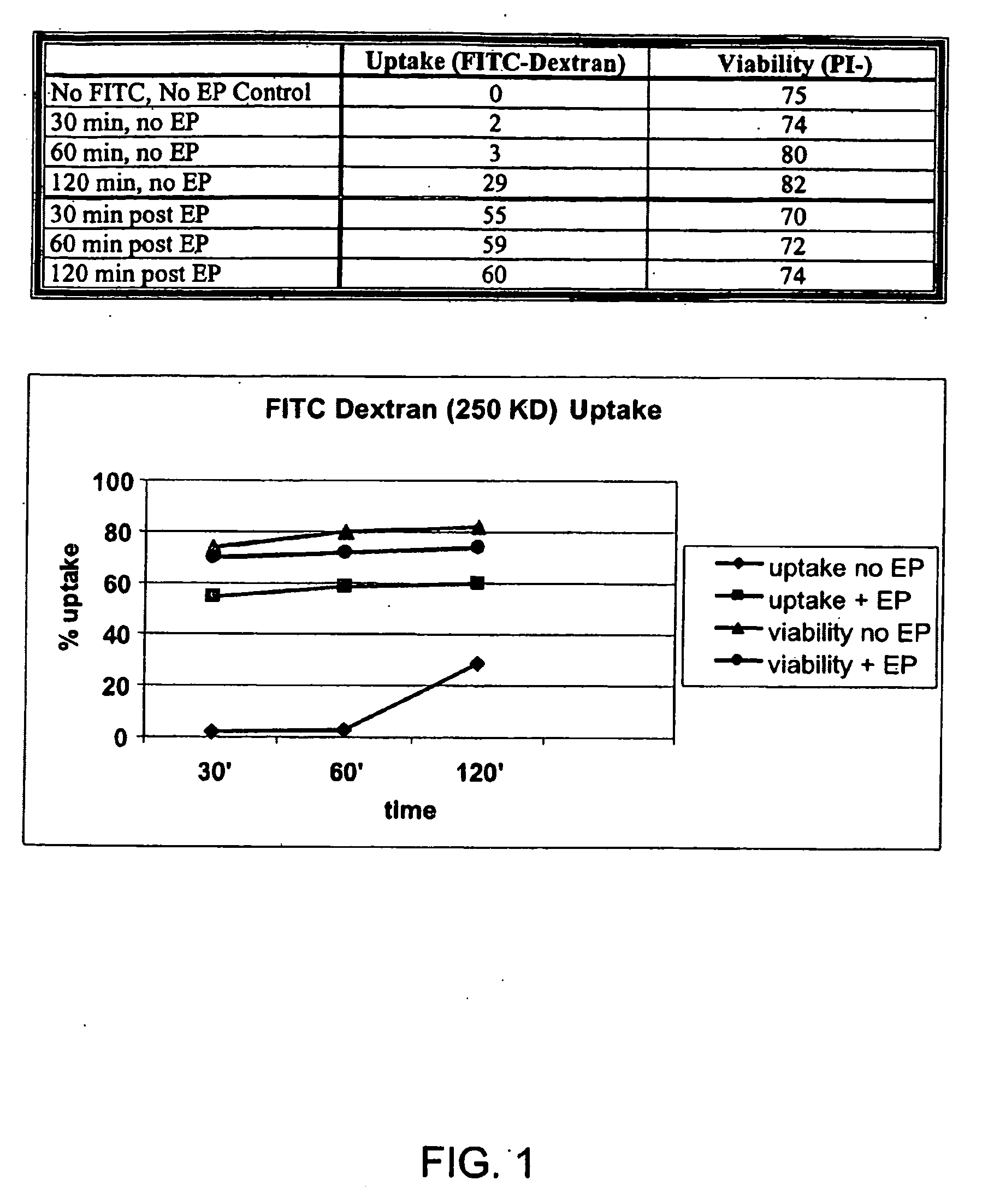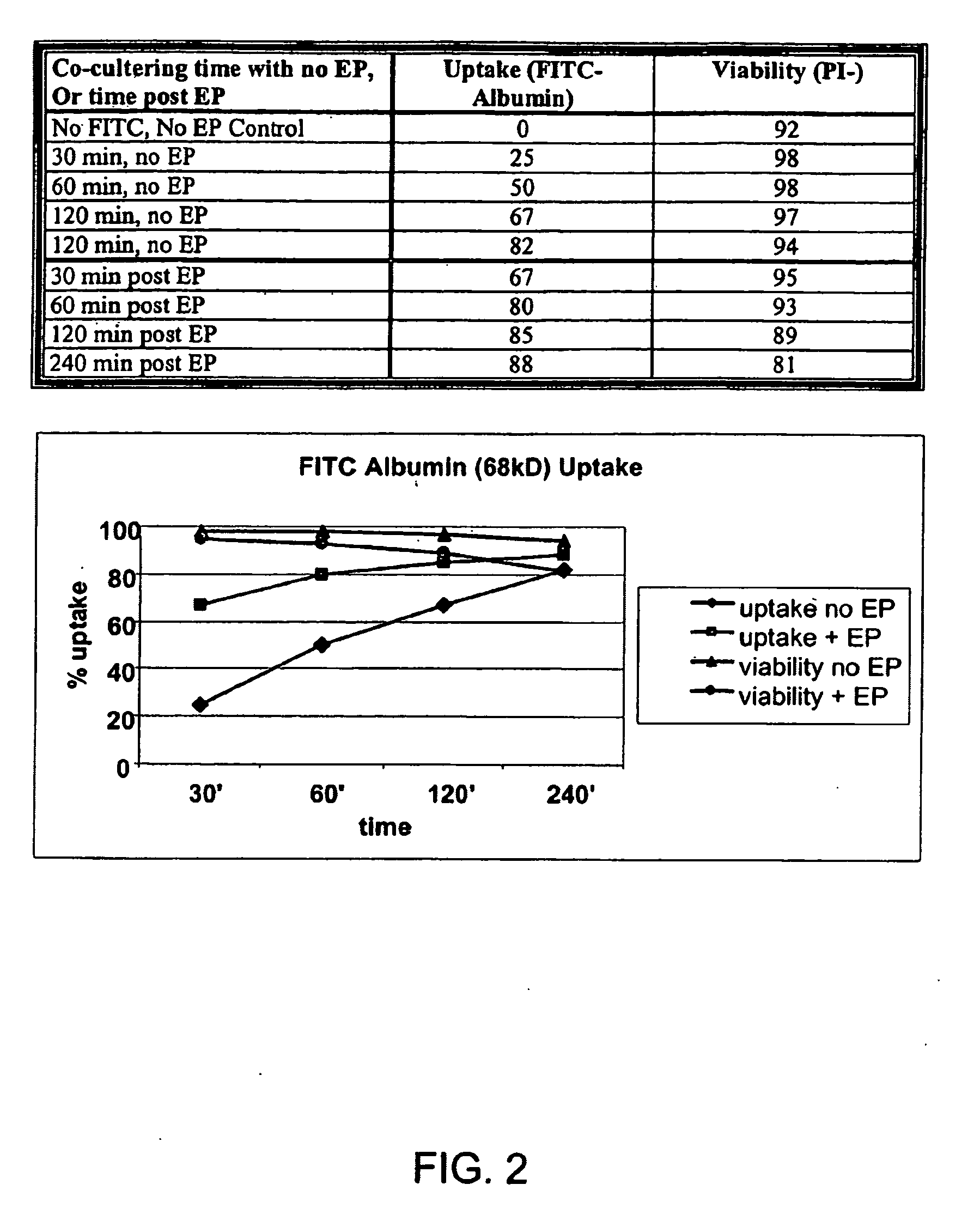Loading of cells with antigens by electroporation
- Summary
- Abstract
- Description
- Claims
- Application Information
AI Technical Summary
Benefits of technology
Problems solved by technology
Method used
Image
Examples
example 1
Isolation of Murine DCs
[0158] Mouse bone-marrow derived DCs were isolated from 8-12 day old Balb / C mice. Tibia and femur of the mice were removed and cleaned. The bone marrow cells were collected by flushing the bones with tissue culture media. The cells were pelleted by centrifugation and resuspended in red blood cell lysis buffer (ACK, Sigma). Cells were washed twice with PBS and then plated a 5×106 cells / ml in AIM-V media supplemented with L-glutamine, penicillin and streptomycin, human serum albumin at 0.2%, mouse GM-CSF at 30 ng / ml, and mouse IL-4 at 10 ng / ml. After three days of culture GM-CSF and IL-4 were added to the cultures to final concentrations of 25 ng / ml and 10 ng / ml, respectively. After an additional 3 days of culture (day 6) the media was replaced with fresh media containing GM-CSF and IL-4 at 25 ng / ml and 10 ng / ml, respectively, together with the other supplements previously used. After an additional 2-4 days the cells in suspension and all adherent cells, the la...
example 2
Isolation of Human DCs
[0159] Human monocyte-derived DCs were isolated from human peripheral blood by centrifugation using standard procedures. The isolated macrophages (approximately 5×108) were washed and plated at 5×106 per milliliter in AIM-V media (Invitrogen) supplemented with L-glutamine, penicillin and streptomycin at standard concentrations used for tissue culture, human serum albumin at 0.2%, 2.0% autologous plasma, 30 ng / ml human GM-CSF, and 10 ng / ml human IL-4 (the latter two growth factors from R & D Systems). The average number of cells per surface area was 108 / 185 cm2.
[0160] After three days of culture GM-CSF and IL-4 were added to the cultures to final concentrations of 25 ng / ml and 10 ng / ml, respectively. After an additional 3 days of culture (day 6) the media was replaced with fresh media containing GM-CSF and IL-4 at 25 ng / ml and 10 ng / ml, respectively together, with the other supplements. After an additional 2-4 days, the cells in suspension and all adherent cel...
example 3
Preparation of Lysate from RENCA, B16-F10, LLC or A375 Tumor Cells
[0161] The mouse renal carcinoma cell line (RENCA), melanoma (B16-F10), Lewis lung carcinoma (LLC) or A375 human melanoma cells were cultured in vitro, grown and collected by trypsinization, washed in phosphate buffered saline (PBS), and then 100×106 cells were resuspended in a 1 ml final volume giving 100×106 cells / ml. The cells were then lysed by freeze / thawing by subjecting them to 5 cycles of rapid freezing and thawing using a dry-ice / alcohol bath and a 37° C. water bath. Tumor lysate was also prepared by injecting mice with 1×106 of these tumor cells, waiting 1-2 weeks to allow for the tumor to grow subcutaneously, and then the resulting tumor mass was dissected and subjected to the same freeze / thawing cycles as described above. After freeze-thawing, the lysates were centrifuged for 10 min at 13,000×g at room temperature, and the supernatants were transferred to 1.5 ml plastic centrifuge tubes (Eppendorf). The s...
PUM
| Property | Measurement | Unit |
|---|---|---|
| Flow rate | aaaaa | aaaaa |
| Mass | aaaaa | aaaaa |
| Hyperproliferative | aaaaa | aaaaa |
Abstract
Description
Claims
Application Information
 Login to View More
Login to View More - R&D
- Intellectual Property
- Life Sciences
- Materials
- Tech Scout
- Unparalleled Data Quality
- Higher Quality Content
- 60% Fewer Hallucinations
Browse by: Latest US Patents, China's latest patents, Technical Efficacy Thesaurus, Application Domain, Technology Topic, Popular Technical Reports.
© 2025 PatSnap. All rights reserved.Legal|Privacy policy|Modern Slavery Act Transparency Statement|Sitemap|About US| Contact US: help@patsnap.com



